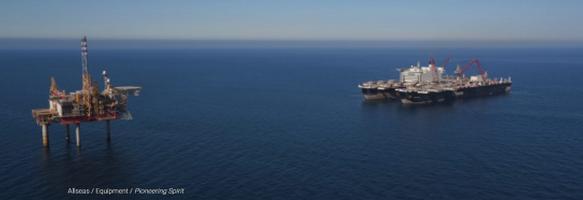 The oil fields beneath the North Sea are running out of oil. As there is less oil to pump, costs rise per tonne of oil delivered from the now aging offshore platforms. A decline in oil prices only makes the economics of these rigs worse and yet they cannot be simply shut down and abandoned. Under a 15-nation protocol called the “Convention for the Protection of the Marine Environment of the North East Atlantic,” known simply as OSPAR, the rigs must be removed and taken ashore for scrapping. To dump them at sea or allow them to decay in place would risk serious environmental damage. But how does one dismantle an offshore rig that can weigh anywhere from 100,000 to 300,000 tonnes of steel? And there are a lot of them. According to the BBC:
The oil fields beneath the North Sea are running out of oil. As there is less oil to pump, costs rise per tonne of oil delivered from the now aging offshore platforms. A decline in oil prices only makes the economics of these rigs worse and yet they cannot be simply shut down and abandoned. Under a 15-nation protocol called the “Convention for the Protection of the Marine Environment of the North East Atlantic,” known simply as OSPAR, the rigs must be removed and taken ashore for scrapping. To dump them at sea or allow them to decay in place would risk serious environmental damage. But how does one dismantle an offshore rig that can weigh anywhere from 100,000 to 300,000 tonnes of steel? And there are a lot of them. According to the BBC:
There are currently 470 oil or gas rigs and 3,000 pipelines in need of decommissioning – and 5,000 wells that need plugging with cement to depths of thousands of metres. The topsides weigh typically in the tens of thousands of tonnes – with, for example, Shell’s Brent Delta platform’s topside weighing in at a cool 24,000 tonnes.
One tool for this massive task is the Pioneering Spirit (formerly Pieter Schelte), the largest construction vessel ever built. The ship has a gross tonnage of 403,342 GT, a breadth of 123.75 m/406 ft and a full load displacement of 900,000 metric tons. The ship is a dynamically positioned catamaran designed to install or decommission offshore platforms and to lay pipe.
Last summer, the ship removed the topside structure of its first rig — Repsol’s 13,500 tonne Yme production unit in the Norwegian North Sea. On April 28th, the Pioneering Spirit set a new record when it removed the 24,000 tonne topside structure from its Brent Delta platform in a single lift operation.
Here is a video of the Pioneering Spirit removing the superstructure of the Yme platform last August.
Pioneering Spirit removing the Yme topsides
Thanks to David Rye for contributing to this post.

Companies that built these structures should have put money aside for their planned removal. Making billions of dollars only to leave their trash behind is no longer acceptable business plan.
http://www.bbc.co.uk/news/av/uk-scotland-39758957/brent-delta-platform-removed-from-legs
This is even more impressive. The 24,000 tonne lift is in real time.
Amazing.
The companies who profited from the rigs are the ones paying for their removal.
Incredible — wouldn’t have believed it unless I saw it.